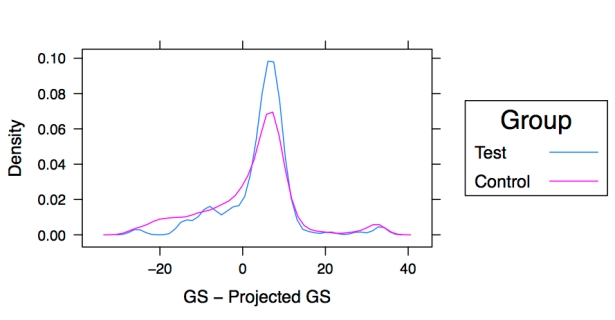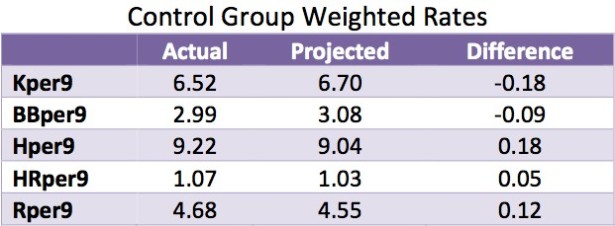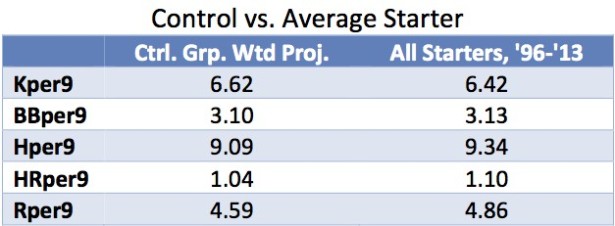Last week, the Washington Nationals lost their opening-round playoff series against the San Francisco Giants, falling 3-2 in Game 4 in San Francisco. The series offered a lot of gripping, exciting baseball; and for one Nationals fan, at least, it was an enriching experience even with the loss. (This post is written from a Nationals fan perspective, but may be of wider interest). After a close playoff series, it is natural to try to understand what happened. I’d like to look at an idea which has surfaced in prominent places in recent days:
** The Nationals suffered from a lack of poise in the face of the heightened pressure in the playoffs; and the Giants exhibited more poise, in a manner which contributed significantly to their victory.
This idea can be found in two recent columns by the Washington Post’s Thomas Boswell (“Washington Nationals must recognize, and embrace, that October is whole new ballgame” and “Hard truth is Nationals are not yet a match for the poised, traditional powers of the NL”, both from October 8). There is similar praise of the Giants in Jayson Stark’s ESPN article “For Giants, it’s ‘ugly, but it works’” (also October 8).
I’m afraid I think reactions like this are superficial. Both teams scored nine runs over four games, so by this familiar measure they were equal. But we all share a tendency to think that the Giants must have won for a good reason: there must be something which distinguishes the two teams. Rather than being unique to inquisitive baseball fans, this desire for an explanation has deep roots far outside the sporting world; it is codified in some circles as “the principle of sufficient reason.”
Regarding the baseball playoffs, this principle is often applied as follows:
Playoff contests between evenly matched teams are often won by the team which possesses more poise. As compared to the regular season, there is more pressure in the playoffs, and what really matters is whether you respond to this with poise. In fact, poise is so important in the playoffs that it often allows a less talented team to beat a more talented team.
Several factors combine to make the poise theory an inevitable diagnosis of the Nationals-Giants series. The Nationals had a better regular season record (96 wins vs. 88 for San Francisco) and are perceived as having more talent. Also, the Giants had established a reputation as a very poised playoff team by winning two of the previous four World Series. From my side of the country, it sounds like they also picked up a reputation for outperforming their regular season record in the playoffs.
Not only that, but in 2012 the Nationals had another excellent regular season before losing to the Cardinals in a five-game first round playoff series. As you know, the Cardinals also have a reputation for being a poised playoff team. And it should not be a surprise that the 2012 Nationals-Cards series seemed to lend itself to the explanation that the Cardinals exhibited more poise.
Our series matched a post-season poise team against a regular-season performer with question marks surrounding its playoff poise. So, after the series concluded in the manner that it did, a logical next step was the appearance of the poise theory.
The problem with the poise theory is that it starts with the winner and works backwards. It cherry-picks moments that are easy to remember, at the expense of more gradual or incremental dynamics. The theory routinely assigns these moments too much significance. Often, this mindset looks at only one side of what happened at various points in the game. The analytical result is that the winner won via poise, and the loser gets no credit for exhibiting poise, or any other positive qualities.
The poise account of the Giant-Nationals series is that the Nationals were frozen by the moment and didn’t hit well, that the Giants tied game 2 when down to their last out (and won it with a poised HR in extra time 9 innings later), that the Nationals made several on-field errors in game 4, and made two questionable (or just bad) bullpen-decisions in games 2 and 4…and that the Giants played gritty, opportunistic, mistake-free baseball throughout the series.
One obvious flaw in the poise account is that the last idea is false: Madison Bumgarner’s throwing error in game 3 allowed the Nationals to score 2 runs in their 4-1 victory. In addition, this error was triggered by a two-strike bunt from Wilson Ramos, which would seem to qualify as an exhibition of playoff poise (and of a player adapting to the moment, etc.).
Why doesn’t Bumgarner’s two-run throwing error count against our attribution of poise to the Giants? One reason is because we are working backwards from the fact that the Giants ultimately won the series. Since the Giants won a close series which can only be explained in terms of poise, elements of the series which clash with this narrative are suppressed to preserve the integrity of the explanation.
The “poise” explanation of the Giants’ victory is also challenged if we admit that the Nationals exhibited poise, because then the two teams do not differ in a way that explains the Giants’ victory.
Unfortunately for the poise theory, the Nationals displayed loads of this quality throughout the series – for example, via a two-strike bunt, via Jordan Zimmermann’s game 2, or via Doug Fister’s game 3. (If you are currently protesting that Ramos’ bunt was very improbable, you are just tracking the series outcome and the prior reputations of the teams).
Also, in game 4, although the Nationals certainly struggled in innings 2 and 7, including loading the bases twice, walking in a run, and throwing a wild pitch — they kept themselves in the game by limiting the total damage to 3 runs. This fact would have played very well in “poise” articles written in the scenario where the Nationals went on to win. It is now somewhat difficult for us to see poise at work in those innings. But again this is perception well shaded by the outcome. This illustrates how in baseball the attribution of poise just tracks who won a close game or series.
The poise theory cherry-picks parts of games; it also cherry-picks parts of plays. In the seventh inning of game 4, after his wild pitch, Aaron Barrett threw a ball over the catcher Ramos’ head; they were trying to walk the batter. But Ramos was able to recover the ball, Barrett covered the plate; and, in a poised, well-executed play, they threw out Buster Posey at the plate, thus preventing another run.
In game 2, with Drew Storen pitching in the 9th, Pablo Sandoval hit a ball down the left-field line which scored one run, which tied the game, and which threatened to score two. But the Nationals made two accurate throws starting from deep left field, and a good tag at the plate, to get Buster Posey (again, so to speak) at the plate.
The poise theory presumably gives Posey credit for pushing the action in close games; and here I agree. But we should also give credit to the Nationals for showing the poise, and, relatedly, the baseball fundamentals, to throw him out twice to prevent runs.
I think a normal look at poise finds it in abundance on both teams in this series. However, the baseball variant of this concept has a different logic. This variant just tracks the winner when the outcome is close.
In addition to the poise issue, there were other interesting aspects of the series.
Although the Nationals were regarded as the better team, the two clubs were not far apart with respect to many regular-season statistical measures.
Nationals batting (pitchers excluded):
.261 avg. / .330 oba / .407 slg. *** 107 wRC+, 151 HR *** 8.6% BB / 20.0% K
Giants batting (pitchers excluded):
.263 avg. / .319 oba / .401 slg. *** 107 wRC+, 128 HR *** 7.2% BB / 19.3% K
The two teams had very similar offenses, although the OBA and HR numbers represent real differences. Also, their K and BB rates cohere (to a small degree) with the idea that the Giants are more of a contact hitting team, in that they swung more (i.e., walked less) and struck out less than the Nationals. One suggestion I’ll make below is that some of the Nationals should have swung a bit more.
Turning to pitching, although the Nationals came in with a better pitching reputation, and although the Nationals have better pitching, this point is not straightforwardly validated by the full range of ERA-like measures made available by contemporary analysis:
Nationals: 3.03 ERA / 3.18 FIP / 3.43 xFIP
Giants: 3.50 ERA / 3.58 FIP / 3.59 xFIP
The pitching stats converge as we move to measures which factor out balls in play (roughly, FIP) and then factor out the home run/fly ball rate (roughly, xFIP).
FIP and xFIP bring the teams together; so do somewhat blunter measures like runs allowed per game:
Nationals: 3.43
Giants: 3.79
The teams’ xFIP’s were very close, and they were closer than I would have guessed in terms of Runs Allowed. The Nationals had a better record, but I think this was due in part to the Giants just playing the Dodgers more! These teams were closer than the lead-in fanfare communicated.
I’ll offer two observations about the Nationals’ hitting, both of which cut somewhat against the playoff poise theory. The first is that while the Nationals’ offense certainly has a high-gear mode, this is not the only face they present to the world on an ongoing basis. For instance, the non-pitchers were .252 avg. // 101 wRC+ in the first half of this season…vs. a .273 avg. // 115 wRC+ in the second half of the season.
The streakiness is due in part to a group of more or less low-average, high-power players (LaRoche, Desmond, Ramos). These players are somewhat prone to 4-0-0-0 nights anyway, and in the playoffs series the Giants appeared to have good plans for them. My subjective recollection is that there were many at-bats when these players were not close to getting a hit.
But what about the Nats’ better hitters? I am thinking of Rendon and Werth in particular, and again the Giants appeared to have a plan. Here I do have a concrete suggestion about what was going on. Werth and Rendon each had 20 plate appearances in the series, and they both had 10 appearances where they took the first pitch as a called strike. This may be a surprise to you, but I doubt it’s a surprise to the Giants. Werth and Rendon are both deliberate hitters, and I think the Giants resolved to take advantage of this, and to keeping throwing early strikes until Werth and Rendon made them pay.
Of course, Rendon batted .368 for the series, and Werth batted .056. However, Rendon’s hits were all singles, from a 21 HR / 39 2B hitter. The Giants gained an edge here – in a specific, tangible way – and Rendon and Werth didn’t make the requisite adjustment. But this is one piece of a story which could easily have been different. For example, Rendon hit a very deep fly ball in extra-innings game 2, which might have made it to the wall or farther in different wind conditions. Werth had similar misfortune on deep fly balls, the most memorable of which was Hunter Pence’s excellent catch late in Game 4.
The Giants deserve credit for executing a good approach against the Nationals’ hitters. On the other side, the Giants did not exactly light up the Nationals’ pitching. After game 2, the Giants did not score a run off a hit. So I suspect that the Nationals’ pitchers executed similar strategies as well. These layers of the competition are more remote to those of us who observe the game from the outside; but they are probably more significant than psychological differences between the teams.
What about Bryce Harper?
Bryce Harper did more than exhibit poise in this series. Bryce Harper displayed the superlative animal dynamism which our games can extract from us and showcase, the best they can offer. More than any other player, Harper elevated a series marked largely by deadlock and attrition. A series like that does require poise, which both teams showed. A series like that is exciting, but not transcendent. Poets celebrate poise when a contest offers little other inspiration.
OK, what are the proper takeaways?
Boswell writes
If you send the winning run home on a wild pitch (Aaron Barrett); if you can’t field a two-hop grounder back to the mound (Gio Gonzalez); if three players look at each other and none of them picks up a sacrifice bunt attempt (Gonzalez, Anthony Rendon, Ramos); if you can’t throw a strike with the bases loaded and walk home a run (Gonzalez); if you get confused and throw home when no Giant is actually running toward the plate (LaRoche), squandering an out, then you have no business staying at baseball’s October party.
Amen! But why not issue a similar edict against the Giants, who, again, did not score a run off a hit in the last two games? Out of context, that doesn’t sound like a terribly promising formula either.
Boswell also draws an analogy to golf: “Right now, the Nationals are like professional golfers who win a bunch of weekly Tour events but falter under the pressure in major championships.” His remark connects us with a long-running discussion in golf about competitors with various records in the majors (the Masters, the US Open, the British Open, and the PGA Championship) and in regular events. This discussion of golf players is characterized by an all-too-familiar blend of mythology, pop psychology, and information gaps. Nonetheless, I think there are instructive parallels between the majors and the baseball playoffs, which help us understand the recent Nationals-Giants series, and perhaps offer some lessons for the Nationals looking ahead.
Boswell’s peroration about disqualifying mistakes is wrong. Golfers win major tournaments despite serious, embarrassing, incriminating blow-ups. At Carnoustie’s 18th hole on Sunday of the 2007 British Open, Padraig Harrington twice hit his ball into a narrow, winding waterway, but ended up winning a playoff against Sergio Garcia. I am fine with the idea that you have no business trying to win a major if you find the water twice on the 18th hole. But this plausible moral stance is falsified by events. Similarly, in 1999, on the same final hole at Carnoustie, Jean van de Velde elaborated an even greater disaster; he blew a three-shot lead, but still qualified for a playoff.
The significance of an error depends on where you are in the competition and on what your opponents are doing. In a high-pressure situation, they may not be doing very much. At Carnoustie in 2007, the golf course and the moment got the better of everyone, in that the top three finishers (Harrington included) were a combined six over par for the last two holes. At Carnoustie in 1999, the course had been winning all week, in that no one finished under par for the tournament. In fact, van de Velde’s blow-up brought him back to a three-way tie for the lead at 6 over par. Looking at a different golf course, in the 2006 US Open, won by Geoff Ogilvy, the top four finishers all suffered serious damage on the final day, with Phil Mickelson and Colin Montgomerie taking double bogeys on the final hole.
The Nationals should work on their play inside the diamond, but they shouldn’t beat themselves up about it. Everyone is likely to screw up in the furnace of playoff pressure, including the Giants…who yielded two runs on one bunt.
Let’s say that an attrition contest is one in which even the winner takes a beating. Although this model is prominent in major golf, it is not universal. (I’m sure it isn’t in baseball either. But I have a better grasp of recent golf). Some players get a lead early and are never seriously threatened. Many of Tiger Woods’ victories fit this pattern. A recent, more mortal example is Martin Kaymer’s 8-shot victory in the 2014 US Open.
Another interesting major winner is Charl Schwartzel, who birdied the final 4 holes at the 2011 Masters, to resolve a highly fluid final-day horse race in which 8 different players had at least a tie for the lead at different times during the day. Five past or future major winners finished behind Schwartzel in the top 10, as well as Rory McIlroy, who lost a two-stroke lead, shot an 80 for the day, and finished out of the top 10. (McIlroy won the next major in 2011 and has since won three more majors). Schwartzel elevated his play above his competitors at the climax of one of the world’s great sporting events. In this setting, against this group, poise is out as an explanatory variable. Schwartzel won with the sort of imperious dynamism which I have already praised as the most admirable character trait athletic competition reveals to us.
I think the Nationals can win an attrition playoff series, because they almost did. (Just ask the Giants in a candid moment). But playoff success for them is likely to go by a different path. A team which can post a second-half 115 wRC+ (pitchers excluded) without a healthy Ryan Zimmerman and Bryce Harper, while posting a team 2.96 ERA over the same period, may not need to change the way it plays. It may need to embrace the way it plays.
Less poetically, I’m optimistic about what the team can do with a full season of Zimmerman and Harper, Harper, Harper :-).











